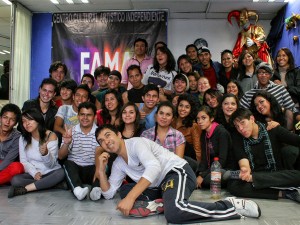By Daniel Higa Alquicira
Infosurhoy.com
MEXICO CITY – Since he was a child, Luis Alberto Ramos Hernández dreamed of singing and dancing on the world’s biggest stages.
But coming from a low-income family in the Colonia Anáhuac of the Miguel Hidalgo borough of Mexico City, there was little opportunity for him to study performance arts.

“It was impossible even to think of pursuing an artistic career,” Ramos, 22, said. “My priority since childhood was to contribute to covering expenses at home, even if this meant forgoing my professional aspirations.”
In 2007, poverty forced him to drop out of school and provide for his family, whether it was by working in a fast food restaurant, selling credit cards, clothes or other merchandise – all jobs he did so his family could make ends meet.
But Ramos’ life changed when he learned a performing arts school geared to young people from at-risk neighborhoods was accepting applications and didn’t charge tuition.
This, he thought, was his chance to grab onto his dream and see how long he could ride it as a dancer and singer.
Ramos is one of 35 students who comprise the first class of Independent Center for Artistic Coaching (Cecarti), which is funded by the Federal District’s Youth Institute (InjuveDF) and opened on June 20.
“All of my life I’ve witnessed criminal gangs, violence and alcoholism. I’ve seen 13-year-old children already smoking, drinking and doing drugs in my neighborhood,” Ramos said. “Studying at the Cecarti has broadened my horizon. Receiving a full education will allow us to have a professional future, which before would have been impossible for us to achieve.”
Cecarti offers students an alternative to committing crimes, abusing narcotics or joining one of the no fewer than 351 gangs based in the Mexico City boroughs of Iztapalapa, Álvaro Obregón, Miguel Hidalgo, Gustavo A. Madero, Tlalpan, and Cuauhtémoc, according to the Federal District government.
The 2011 Judicial Statistics on Penal Matters report claims that 10,808 between the ages of 18 to 29 were charged with crimes such as robbery, battery, assaults, homicides and illegal use of weapons and narcotics that year.
There are 2,336,603 residents aged 14 to 29 in Mexico City, representing about 24% of the city’s population. But 71% percent of these young people live in medium-, high-, and very high- marginalized areas, according to the 2010 survey by the National Institute of Statistics and Geography (INEGI).
“In Mexico we have a serious problem, which is inequality,” said Javier Hidalgo Ponce, the director of InjuveDF, a Mexico City government organization that since 2003 has assisted 10,000 young people through diverse activities such as sports, culture, education, and community work. “That’s why we get involved in helping these young people, so they can overcome those obstacles and get out of their environments and develop.”
Cecarti is part of the InjuveDF’s Program for Attention to Young People At-Risk.
“Cecarti is an idea conceived jointly by 12 teachers who, out of a big heart and great conviction, coach young people with aspirations of acting, dancing and singing,” he added.
The two-year curriculum includes acting, jazz, singing, musical scale, history of the theater, cultural history, contemporary dance, theater production, mask making, theatrical makeup and film analysis classes.
“It’s much better to be studying singing, dancing and acting, than to be in the streets using drugs and living among the gangs,” Ramos said. “It’s a way of staying away from all the factors that harm society.”
The center is open to all young people interested in performing arts and who live in high-risk areas.
“Before coming to the Cecarti many of the students didn’t know what to do – they were mired in depression and drugs,” said Grimaldo Sosa García, Cecarti’s drama director. “But in the performing arts, they’ve found a platform from which to overcome their reality and envision a promising future. Now, they work hard toward their goals, which in the past appeared impossible.”
Ramos said his family supports his dream.
“My family has changed in the way it perceives the arts and theatrical expressions, as they used to think of these as hobbies or a waste of time,” Ramos said. “They mocked me when I said ‘I wanted to be a professional actor and dancer.’ Now, they’re even proud of me.”




